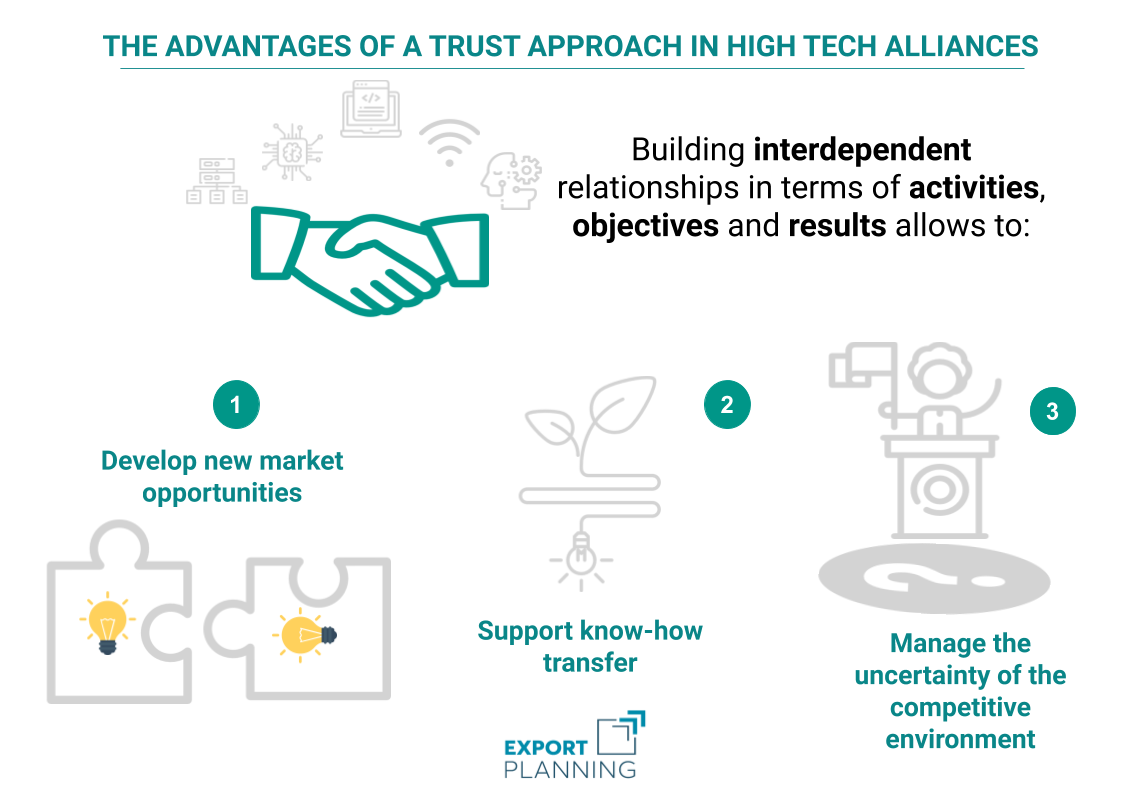Strategic trust-based alliances: naive or strategic approach?
An example of Market Entry Strategy for knowledge-based Industries
Published by Marzia Moccia. .
SME Bestpractice Internationalisation International marketing
In building an international strategic alliance between two or more companies, literature suggests as a best practice the development of a trust-based relationship between the parties, as an alternative to the contract-based relation.
The case of the high-tech sector allows to analyze all the benefits linked to the fiduciary approach, underlining how this type of approach guarantees different strategic opportunities.
For hight-tech companies one of the main purpose is to develop a specialist know-how that can guarantee continuous innovation. However it's very difficult that companies present the right combination of product, market, technology and competence in-house in order to guarantee this results in approaching a foreign market, especially if we talk about Small and medium enterprises.
For this reason, international partnerships in the high-tech sector aim to develop a highly specialized knowledge to operate in a competitive context and to develop new innovation opportunities.
Main aims of international alliances in high-tech industry: development of know-how, high reactivity to the competitive context, continuous innovation
At the same time, however, the sharing of business know-how and confidential information between partners hides substantial risks for the parties, since competitive advantage of high-tech companies is based on their distinctive knowledge. Companies motivated to build an alliance tend to focus on the spillover effects during the negotiation phase, trying to prevent the risk of opportunism of the partner through specific deterrence tools included in the agreement. This approach would seem to reflect a principle of irrefutable rationality at first glance, but empirical evidence suggests that it is one of the most common reasons for the failure of an alliance1.

|
|---|
Risk prevention or value creation?
The main advantage of privileging a trust-based approach in this context is a change of perspective: the focal point of the alliance is no longer mere risk protection, but the definition of the possibility of creating added value. Indeed, the optimal strategic approach consists in exploiting the complementarity of the partners by building relationships of interdependence in terms of activities, objectives and results. The ability of the partners to create strong relationships of interdependence is functional to laying the foundations for the development of intrinsically joint opportunities that could not be achievable without the contribution of each partner. The report will therefore be focused on the possibility of creating added value and on the awareness that making margins necessarily depends on the cooperative activity of both partners.
Interdependencies of activities, objectives and results are the basis for added value creation jointly
Interdependence increases the cooperative activity of partners as it encourages the construction of a trust-based relationship: the free exchange of information is fostered, transfer of knowledge increases, an equal relationship between partners establishes and it reduces agreement costs.
These activities make it possible to develop specialized know-how, to enhance the development of new opportunities and to guarantee the parties greater flexibility in adapting to contingencies. The construction of a trust-based relationship allows, therefore, to meet the challenging requirements of the high-tech sector: promotes the growth of know-how, protects the creation of new ones opportunity and govern the uncertainty of the competitive environment, as documented by a series of studies on knowledge-intensive industry2.
In a strategic trust-based alliance, the agreement might be an organisational instrument and not a deterrent
Moreover, the literature of case studies documents that the construction of a trust mechanism between the parties changes the role of the agreement: the written form becomes signal of commitment, where are defined goals, roles and rules.
The written agreement is not to be understood, therefore, as a means of deterrence, but it aims to ensure continuous coordination between parties. To this end, it might evolve from a static to a dynamic tool in order to incorporate possible changes in alliance's items.
(1) See De Jong G. (2016), Successful Strategy and Alliances, University of Groningen, Centre For Sustainable Entrepreneurship Monograph Series, No. 3.
(2) Blomqvist K. e al. (2008), The role of trust and contracts in the internationalization of technology-intensive Born Globals, Journal of Engineering and Technology Management 25 1-2: 123-135;
De Jong G. (2016), Successful Strategy and Alliances, University of Groningen, Centre For Sustainable Entrepreneurship Monograph Series, No.3;
Johanson J. e Vahlne J. (2009), The Uppsala internationalization process model revisited: from liability of foreignness to liability of outsidership, Journal of International Business Studies 40: 1411;
Saarenketo S. e al. (2004), Dynamic knowledge-related learning processes in internationalizing high-tech SMEs, International Journal of Production Economics 89: 363–378.


